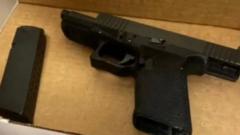The recent shooting of healthcare executive Brian Thompson has reignited discussion around ghost guns, a type of firearm that can be easily assembled at home, often without serial numbers, making them untraceable.
Ghost Guns: The Controversial Weapon Linked to Healthcare CEO's Death

Ghost Guns: The Controversial Weapon Linked to Healthcare CEO's Death
A deep dive into the ghost gun phenomenon amidst the rising concern over untraceable firearms.
In the wake of Brian Thompson's tragic murder, the investigation has turned its focus toward the weapon allegedly utilized by the suspect, Luigi Mangione. Authorities have indicated that the gun recovered from Mangione likely qualifies as a ghost gun—a firearm that can be built at home with parts obtained through kits, or even printed using 3D technology. This particular weapon described in the arrest warrant was identified as a semi-automatic pistol, featuring a 3D-printed loaded receiver going hand-in-hand with a metal slide and a silencer, capable of firing 9mm rounds.
Ghost guns are called "ghosts" for their untraceable nature; they lack serial numbers which makes it nearly impossible for law enforcement to identify their origins. Advocacy groups have characterized the rise of these firearms as the "fastest growing gun safety problem" in the United States, spotlighting the challenges in regulation and control.
The Biden administration, pointing to concerns about the ease of assembling these firearms, has called for tighter regulations. Notably, prior to August 2023, individuals could procure various parts for ghost guns online without undergoing background checks. Online resources enable anyone with basic technical knowledge to assemble a fully-functioning firearm in under an hour.
Statistics provide a clearer picture of the ghost gun crisis; data from the Bureau of Alcohol, Tobacco, Firearms and Explosives (ATF) reveals that approximately 20,000 ghost guns were involved in criminal investigations throughout 2022—a striking increase from just 2,000 in 2016. Experts argue that the absence of serial numbers complicates tracking down those who sell these guns illegally, especially to vulnerable populations, including minors.
Former government official Juliette Kayyem expressed skepticism about whether tragic incidents like Thompson's would compel Americans to rethink the presence of ghost guns in society. She articulated that the difficulties surrounding gun control in America are deeply ingrained in the nation’s complicated relationship with firearms. In 2022 alone, gun-related deaths in the U.S. surpassed 48,000 according to the CDC—a stark reminder of the urgent need for action.
Amidst this backdrop, the Biden administration has signaled a commitment to regulating ghost guns as though they were commercially available firearms. Current legislation mandates that manufacturers include serial numbers on their products and conduct background checks on buyers. Encouragingly, the U.S. Supreme Court has shown a willingness to support these regulations, despite challenges posed by gun rights advocates arguing that it oversteps existing laws.
In a country where gun rights remain a fiercely debated issue, scrutiny of ghost guns is intensifying, revealing the complexities of tackling gun violence and ensuring public safety.
Ghost guns are called "ghosts" for their untraceable nature; they lack serial numbers which makes it nearly impossible for law enforcement to identify their origins. Advocacy groups have characterized the rise of these firearms as the "fastest growing gun safety problem" in the United States, spotlighting the challenges in regulation and control.
The Biden administration, pointing to concerns about the ease of assembling these firearms, has called for tighter regulations. Notably, prior to August 2023, individuals could procure various parts for ghost guns online without undergoing background checks. Online resources enable anyone with basic technical knowledge to assemble a fully-functioning firearm in under an hour.
Statistics provide a clearer picture of the ghost gun crisis; data from the Bureau of Alcohol, Tobacco, Firearms and Explosives (ATF) reveals that approximately 20,000 ghost guns were involved in criminal investigations throughout 2022—a striking increase from just 2,000 in 2016. Experts argue that the absence of serial numbers complicates tracking down those who sell these guns illegally, especially to vulnerable populations, including minors.
Former government official Juliette Kayyem expressed skepticism about whether tragic incidents like Thompson's would compel Americans to rethink the presence of ghost guns in society. She articulated that the difficulties surrounding gun control in America are deeply ingrained in the nation’s complicated relationship with firearms. In 2022 alone, gun-related deaths in the U.S. surpassed 48,000 according to the CDC—a stark reminder of the urgent need for action.
Amidst this backdrop, the Biden administration has signaled a commitment to regulating ghost guns as though they were commercially available firearms. Current legislation mandates that manufacturers include serial numbers on their products and conduct background checks on buyers. Encouragingly, the U.S. Supreme Court has shown a willingness to support these regulations, despite challenges posed by gun rights advocates arguing that it oversteps existing laws.
In a country where gun rights remain a fiercely debated issue, scrutiny of ghost guns is intensifying, revealing the complexities of tackling gun violence and ensuring public safety.























